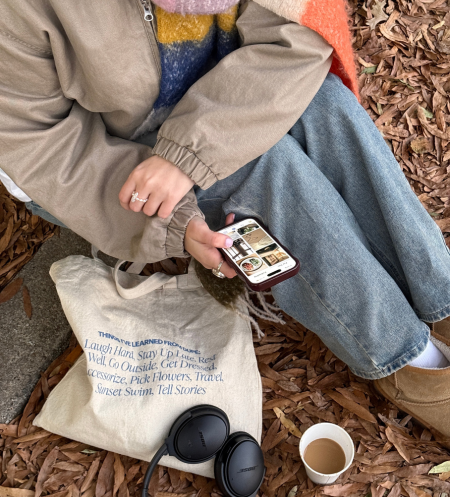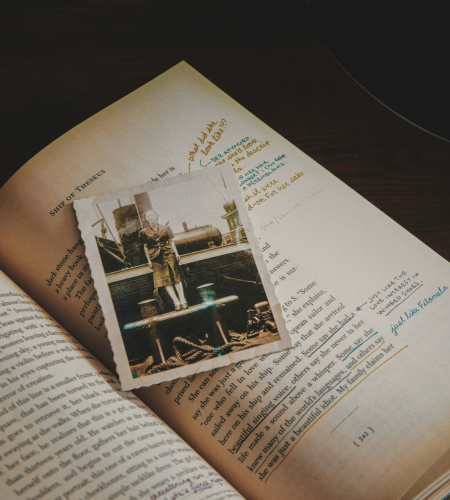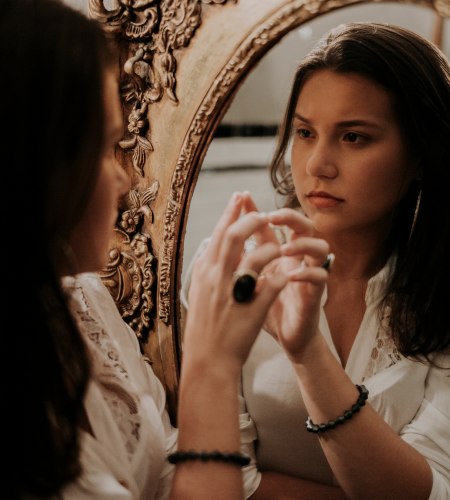
Last week.
Was.
Hell.
I went into detail about my hellish week in the podcast episode, “Hello Perfectionism, My Old Friend” (link), but in case you missed it, here’s an update.
I knew launching this brand was going to push me into unknown territory that would cause me to face my insecurities in a new way. But to be honest, I wasn’t expecting to have to pull out so many tools just to get me back to a neutral state.
Somewhere along the road my mindset shifted from ‘oh this is fun’ to ‘no, I’m determined to make this brand grow’. I completely psyched myself out, told myself that in order to succeed with this brand, I needed to follow the crowd and what other people (teachers in a content creation course I was taking) were telling me to do. Not only did it cause me to completely loose my purpose, but it caused me to feel stress that I haven’t felt in over a year.
The lesson I was able to pull out of my stressful week was that my perfectionism tendencies were rearing their ugly head again, and I talked a lot about why perfectionism is rooted in insecurities. If you’re interested in hearing about that, you can listen to here.
What specifically happened was that I convinced myself that I needed to create a specific blog post by a specific date. Where did this expectation come from? Well, the idea of the blog post came from something I heard in a course I was taking, but the expectation to do it in a certain way by a certain date? Well. That came from me. Myself. I made it up. And I took this expectation as reality. Without realizing it of course.
We tend to do that, don’t we? Put expectations on ourselves without realizing. And then take them as truth, forcing ourselves to meet them even when they don’t feel right.
This self inflicted expectation caused more overwhelm than I knew what to do with. I couldn’t get a grip on my thoughts. The stress and fear of failure made me want to run away from humanity. I wanted to escape. I wanted to turn off my brain. Press pause on the world for a second. I wanted to crawl in my bed and pull the sheets over my head and hide. I felt like I couldn’t escape myself. Like I couldn’t escape my thoughts.
Have you ever felt like this?
When I finally took a step back to assess what was going on in my head, here were the thoughts that sent me in my downward spiral.
“I need to get this post written before Monday”. But it was an article that I wasn’t inspired by. So what happens when we’re not inspired? Nothing comes. I was dry of ideas. Which lead me to my next thought…
“I’m not good enough to start a blog”.
One thought led to the next without me even thinking about it, and in the blink of an eye, I had created a web of negative thoughts that was so suffocating, I couldn’t see the light anymore. These two thoughts, together, completely uprooted my whole week, and kicked up old patterns, insecurities, and limiting beliefs I thought I had overcome.
I was a mess.
I want to share one of the tools that liberated me from this downward spiral.
What I used to clean up this web of thoughts was the 4 questions taught by Byron Katie.
Have you heard of Bryon Katie? I read her book, Loving What Is, about 4 years ago, and her process of challenging your thoughts is a tool I keep in my self care tool box.
If you’re not familiar with Byron Katie’s work, here is her book “Loving What Is” (link).
A short synopsis: Katie fell into a deep depression in her early thirties. During this dark time in her life, she realized that the root of her suffering was her thoughts. She was believing her thoughts to be true, and when she did that, is caused her to suffer. When she didn’t believe her thoughts, she was happy. So the premise of the book is to teach the 4 questions she used to pull herself out of that deep depression. These questions act as a way to self-examine your thoughts.
Seems too simple right? I just have to challenge my thoughts and I can become free of them? It only seems crazy because we are programmed to believe that we are our thoughts. But we are not our thoughts.
I hate to break it to you, but our thoughts are usually not an accurate representation of reality. Our thoughts are just our PERCEPTION of reality. To understand this, just think about how one thing can happen, and 2 people will have totally different thoughts about the situation. Does that mean that either person is wrong? No. It just means that there are 3 sides to the story. Person 1’s, Person 2’s, and reality.
Katie developed these 4 questions so that we can challenge our thoughts and challenge our perception of reality to end our suffering. The goal of these 4 questions is to break you out of your thoughts and bring you back to what is actually happening. Because the root of our suffering is always caused by trying to change reality. So, when we can accept reality for what it is, we can end our suffering.
To Katie’s point, we need to just let things be. To accept them. It is what it is, and if we try to change what is, we’ll only cause ourselves to suffer.
The most basic example is if you have a banana in front of you. The reality of the situation is that you are holding a banana. But if you’re telling yourself it’s an apple. No matter what you think, it will not change the reality that what is in front of you is a banana. And if you keep trying to convince yourself that it’s an apple, it’s going to cause some sort of suffering (“I just don’t understand W H Y this isn’t an apple).
We always have a choice of how to respond to whatever is happening in our lives. We can choose to accept and deal with reality, or we can choose to fight reality and face the suffering it causes.
Her work is fascinating, and life changing. If you want to learn more about that, I wrote a post about it here (write post and link).
Here are the 4 questions that helped liberate me from my thoughts
I knew I needed to get unstuck from my thoughts that were causing me so much suffering, so much anxiety and stress. So I turned to Katie’s questions, which are:
- Is this thought true?
- Can you absolutely know that it’s true?
- How do you react when you believe that thought?
- Who would you be without the thought?
And then, once you answer all 4 questions, turn the thought around. Change that thought to the opposite of what you believe.
How I used the 4 questions
So let me take my 2 thoughts through her questions so you can see how I untangled them.
Thought #1: I need to get this post written before Monday
- Is this true? No. There is literally no pressure to get this posted before Monday. I am the only one pressuring myself.
- Can you absolutely know that it’s true? Since I already said no to #1, I can skip this question. We already know that this thought is not true.
- How do you react when you believe this thought? I’m not inspired to write that post, so I feel very anxious. I feel overwhelmed. I want to crumble at the stress.
- Who would you be without the thought? Well, I’d be a lot happier. I’d be able to move on from that idea and actually start working on a post that I’m inspired to write.
Then, turn the thought around to the opposite of what you believe.
I do not need to get this post written before Monday.
Voila. I can now see that the thought I’m having is NOT true, so why would I continue to believe a thought that is not true? It also showed me how much happier I would be if I just decided to release that thought and act in a different way. The turned around thought makes me feel WAY better, so I’m going to choose to believe that thought instead. Because, remember, we have a choice in what thoughts we want to believe.
Let’s try the other thought.
Thought #2: I’m not good enough to start a blog
- Is this true? This thought was very strong, so let’s say yes. This is true.
- Can you absolutely know that it’s true? Absolutely? Well, no. I guess I can’t absolutely know that it’s true. I’m sure if I kept working at it, it would get easier and I know that I can accomplish anything if I keep working at it. Especially if it’s something I’m passionate about. So no, this thought is not true.
- How do you react when you believe this thought? I feel like a failure. I feel really crappy. Like I’m not enough. Like I’m not capable of accomplishing anything.
- Who would you be without the thought? I would feel free without this thought. I would feel capable. I would feel inspired to keep trying.
Now, turn the thought around to the opposite of what you believe.
I am good enough to start a blog. I know that this is just a new experience for me so there is going to be a learning curve. I know that if it’ll get easier the more I work at it.
WOW, that thought feels a whoooooolleeee lot better to think. And because now I know that the old thoughts aren’t true, every time they pop into my head, I can tell myself that it’s not true. Even if I have to remind myself over and over and over again.
So in summary….
In this situation, if I continued to believe my thoughts, I would have folded under pressure and thrown in the towel after one bump in the road. Or I would have trudged along, experienced burnout, and put out content I didn’t feel good about.
But taking these thoughts through the 4 questions allowed me to not only see that they were irrational, but to see how much happier I would be without them. From there, I was able to decide not to release them, and choose to not believe them anymore!
As humans, we do this often. We take one thought and completely blow it out of proportion. We attach narratives to it and allow them to confirm our deepest insecurities. And if we’re not self aware enough in the moment to catch ourselves, we believe those thoughts, and the narratives we attach to it, are truth.
But our thoughts almost never represent reality. They are almost always our perception of reality, which is skewed based on our traumas, limiting beliefs, fears and insecurities. We have the ability to challenge our thoughts. We do not have to stay victim to our circumstances.
Walking your thoughts through the 4 questions allows you to see your thoughts as just that, a thought. It takes you out of your head and puts you back into reality. And if the thought doesn’t feel good, it gives you permission to release that it’s control over you and choose a new one instead.
Katie says a thought is no different from a raindrop. Would you let a raindrop control your life?
See if it works for you. I return to these questions often when I need a reminder that I am causing my own suffering.
And more times than not, once I’ve worked through the questions? Done, thought demolished.
Try it out, and let me know if it works for you!
xo, Adreanna
Intrigued? Here are some links that may be helpful.
A link to Byron Katie’s book so you can transform your thoughts.
A more detailed review of Byron Katie’s book.
A link to hear more about how awful the week leading up to this post was, and what it taught me about perfectionism.







+ view comments . . .
+
view comments . . .
-